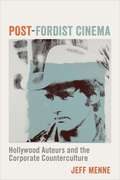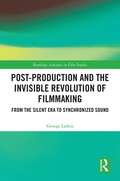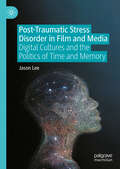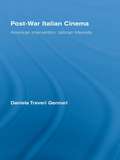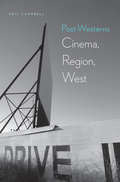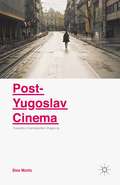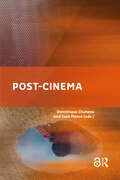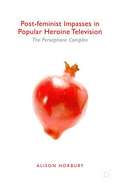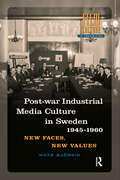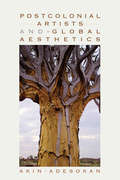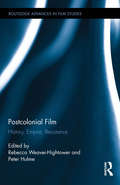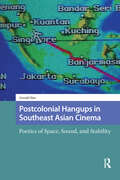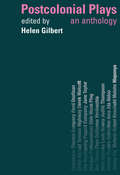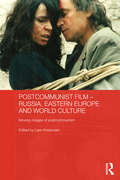- Table View
- List View
Post-Crisis European Cinema: White Men in Off-Modern Landscapes
by György KalmárThis book explores the cinematic representations of the pervasive socio-cultural change that the 21st century brought to Europe and the world. Discussing films such as I, Daniel Blake, Cold War and Jupiter’s Moon, it puts distinctively “post-crisis”, gendered representations in a complex, theoretically informed and socially committed interdisciplinary perspective that maps the newly emerging formations of masculinity at a time of rapid socio-economic transition. Kalmar argues that the series of crises that started with the 9/11 terrorist attacks changed some of our fundamental expectations about history, debunked many of our grand narratives, and thus changed the cultural logic of our (thoroughly globalized) civilization. The book focuses on the ways cinema reflects, interprets and shapes a rapidly changing world: the hot issues of the times, the new formations of identity, and the shifts in cinematic representation. This is an interdisciplinary research that is equally interested in what new the 21st century brought about, most specifically to Europe and to its white men, as in film and its responses to these socio-cultural changes.
Post-Digital, Post-Internet Art and Education: The Future is All-Over (Palgrave Studies in Educational Futures)
by Kevin Tavin Gila Kolb Juuso TervoThis open access edited volume provides theoretical, practical, and historical perspectives on art and education in a post-digital, post-internet era. Recently, these terms have been attached to artworks, artists, exhibitions, and educational practices that deal with the relationships between online and offline, digital and physical, and material and immaterial. By taking the current socio-technological conditions of the post-digital and the post-internet seriously, contributors challenge fixed narratives and field-specific ownership of these terms, as well as explore their potential and possible shortcomings when discussing art and education. Chapters also recognize historical forebears of digital art and education while critically assessing art, media, and other realms of engagement. This book encourages readers to explore what kind of educational futures might a post-digital, post-internet era engender.
Post-Fordist Cinema: Hollywood Auteurs and the Corporate Counterculture (Film and Culture Series)
by Jeff MenneThe New Hollywood boom of the late 1960s and 1970s is celebrated as a time when maverick directors bucked the system. Against the backdrop of counterculture sensibilities and the prominence of auteur theory, New Hollywood directors such as Robert Altman and Francis Ford Coppola seemed to embody creative individualism. In Post-Fordist Cinema, Jeff Menne rewrites the history of this period, arguing that auteur theory served to reconcile directors to Hollywood’s corporate project.Menne traces the surprising affinities between auteur theory and management gurus such as Peter Drucker, who envisioned a more open and flexible corporate style. In founding production companies, New Hollywood filmmakers took part in the creation of new corporate models that emphasized entrepreneurial creativity. For firms such as Kirk Douglas’s Bryna Productions, Altman’s Lion’s Gate Films, the Zanuck-Brown Company, and BBS Productions, the counterculture ethos limbered up the studio system’s sclerotic production process—with striking parallels to how management theory conceived of the role of the individual within the firm. Menne offers insightful readings of how films such as Lonely Are the Brave, Brewster McCloud, Jaws, and The King of Marvin Gardens narrate the conditions in which they were created, depicting shifting notions of work and corporate structure. While auteur theory allowed directors to cast themselves as independent creators, Menne argues that its most consequential impact came as a management doctrine. An ambitious rethinking of New Hollywood, Post-Fordist Cinema sheds new light on the cultural myth of the great director and the birth of the “creative economy.”
Post-Production and the Invisible Revolution of Filmmaking: From the Silent Era to Synchronized Sound (Routledge Advances in Film Studies)
by George LarkinPost-Production and the Invisible Revolution of Filmmaking studies the discourses surrounding post-production, as well as the aesthetic effects of its introduction during the 1920s and 1930s, by exploring the philosophies and issues faced by practitioners during this transitional, transformative period. The introduction of post-production during the transition from silent cinema to the synchronized sound era in the 1920s American studio system resulted in what has been a previously unheralded and invisible revolution in filmmaking. Thereafter, a film no longer arose from a live and variable combination of audio and visual in the theater, as occurred during the silent film era, where each exhibition was a singular event. The new system of post-production effectively shifted control of a film’s final form from the theater to the editing room. With this new process, filmmakers could obtain and manipulate an array of audio elements and manufacture a permanent soundtrack. This transition made possible a product that could be easily mass-produced, serving both to transform and homogenize film presentation, fundamentally creating a new art form. With detailed research and analysis and nearly 50 illustrations, this book is the ideal resource for students and researchers of film history and post-production.
Post-Revolution Nonfiction Film: Building the Soviet and Cuban Nations (New Directions in National Cinemas)
by Joshua MalitskyA study of how the state has used documentary films to create historical and political narratives in the Soviet Union and Cuba.In the charged atmosphere of post-revolution, artistic and political forces often join in the effort to reimagine a new national space for a liberated people. Joshua Malitsky examines nonfiction film and nation building to better understand documentary film as a tool used by the state to create powerful historical and political narratives. Drawing on newsreels and documentaries produced in the aftermath of the Russian revolution of 1917 and the Cuban revolution of 1959, Malitsky demonstrates the ability of nonfiction film to help shape the new citizen and unify, edify, and modernize society as a whole. Post-Revolution Nonfiction Film not only presents a critical historical view of the politics, rhetoric, and aesthetics shaping post-revolution Soviet and Cuban culture but also provides a framework for understanding the larger political and cultural implications of documentary and nonfiction film.“A splendid and highly readable book which imbues a suggestive comparison of cinema in the early years of the Soviet and Cuban revolutions with fresh insights.” —Michael Chanan, author of Cuban Cinema“Joshua Malitsky here mines a rich seam. By closely comparing Vertov and Alvarez he uncovers “post-revolutionary nonfiction film” as a discernible entity with commonalities shared across time and cultures. The extensive—indeed vast—archive of newsreels from both filmmakers is well worth the thorough attention he gives it, suggesting a context for their better-known documentaries. And his situating of Esfir Shub’s compilations as not so much an alternative to Vertov but rather a wholesale replacement approach to agitprop is also compelling. All in all, Malitsky offers a crucial corrective to much received thinking on 20th century radical film.” —Brian Winston, University of Lincoln, UK
Post-Soul Satire: Black Identity after Civil Rights
by James J. Donahue Derek C. MausFrom 30 Americans to Angry White Boy, from Bamboozled to The Boondocks, from Chappelle's Show to The Colored Museum, this collection of twenty-one essays takes an interdisciplinary look at the flowering of satire and its influence in defining new roles in black identity. As a mode of expression for a generation of writers, comedians, cartoonists, musicians, filmmakers, and visual/conceptual artists, satire enables collective questioning of many of the fundamental presumptions about black identity in the wake of the civil rights movement. Whether taking place in popular and controversial television shows, in a provocative series of short internet films, in prize-winning novels and plays, in comic strips, or in conceptual hip-hop albums, this satirical impulse has found a receptive audience both within and outside the black community. Such works have been variously called “post-black,” “post-soul,” and examples of a “New Black Aesthetic.” Whatever the label, this collection bears witness to a noteworthy shift regarding the ways in which African American satirists feel constrained by conventional obligations when treating issues of racial identity, historical memory, and material representation of blackness. Among the artists examined in this collection are Paul Beatty, Dave Chappelle, Trey Ellis, Percival Everett, Donald Glover (a.k.a. Childish Gambino), Spike Lee, Aaron McGruder, Lynn Nottage, ZZ Packer, Suzan Lori-Parks, Mickalene Thomas, Touré, Kara Walker, and George C. Wolfe. The essays intentionally seek out interconnections among various forms of artistic expression. Contributors look at the ways in which contemporary African American satire engages in a broad ranging critique that exposes fraudulent, outdated, absurd, or otherwise damaging mindsets and behaviors both within and outside the African American community.
Post-Traumatic Stress Disorder in Film and Media: Digital Cultures and the Politics of Time and Memory
by Jason LeeThis book expounds how post-traumatic stress disorder (PTSD) became so ubiquitous. The relationships between trauma, memory, and media, including the cultural, psychological, and social dimensions of PTSD are analysed. This work provides an examination of PTSD across diverse cultural contexts, shedding light on its profound impact on human experience and societal structures. This work addresses the role of social media internationally, the pornography industry, and conspiracy theories, in perpetuating trauma and shaping societal attitudes. From feature films, including Apocalypse Now, The Deer Hunter, and Jacob’s Ladder, to hit television shows such as the BBC’s Bodyguard, visual cultures have been instrumental in popularizing an understanding of PTSD. Often these are traditional “triumph over adversity” narratives. In others what is relevant is the wider postwar political landscape. Controversial wars have led to mental health problems for returning soldiers, depicted as part of a metaphoric wound for a nation. At its heart, America is concerned with the survival of the fittest, a Social Darwinist creed fused with manifest destiny and turbo capitalism. Any weaknesses, such as mental problems including PTSD, contradicted and challenged the essence of the pioneering American spirit. A book on PTSD at this moment is necessary, as the subject has become popularized and politicized, just as “madness” became a term to define an era. Through advocating for interdisciplinary approaches to foster healthier perspectives and support, here we come to a deeper understanding of how digital cultures have impacted the politics of time and memory.
Post-War Italian Cinema: American Intervention, Vatican Interests (Routledge Advances in Film Studies)
by Daniela Treveri GennariThrough a comparative approach of current theories developed on ideology and an analysis of official documents from the Vatican and the United States Department of State, the book investigates the decisive role that American production companies played in the development of the Italian film industry and their links to the Vatican. This analysis evaluates how the Italian production and distribution industries satisfied the American political and economic interests. American political and cultural ideology of the post-1945 era, is compared with the Roman Catholic ideology in order to assess their cultural propaganda. This is followed by studies of the roles played by key individuals, such as Giulio Andreotti, and institutions such as ANICA and A.G.I.S. involved in formulating the policies and regulations that affected the production and distribution of American and Italian films in the post-1945 era, as well as the involvement of the Roman Catholic Church in this process.
Post-Westerns: Cinema, Region, West (Postwestern Horizons)
by Neil CampbellDuring the post-World War II period, the Western, like America&’s other great film genres, appeared to collapse as a result of revisionism and the emergence of new forms. Perhaps, however, as theorists like Gilles Deleuze suggest, it remains, simply &“maintaining its empty frame.&” Yet this frame is far from empty, as Post-Westerns shows us: rather than collapse, the Western instead found a new form through which to scrutinize and question the very assumptions on which the genre was based. Employing the ideas of critics such as Deleuze, Jacques Derrida, and Jacques Rancière, Neil Campbell examines the haunted inheritance of the Western in contemporary U.S. culture. His book reveals how close examination of certain postwar films—including Bad Day at Black Rock, The Misfits, Lone Star, Easy Rider, Gas Food Lodging, Down in the Valley, and No Country for Old Men—reconfigures our notions of region and nation, the Western, and indeed the West itself.Campbell suggests that post-Westerns are in fact &“ghost-Westerns,&” haunted by the earlier form&’s devices and styles in ways that at once acknowledge and call into question the West, both as such and in its persistent ideological framing of the national identity and values.
Post-Yugoslav Cinema and the Shadows of War: A Study of Non-Representation in Film (Film Culture in Transition)
by Asja MakarevicBosnia-Herzegovina is still considered a post-war country. The concept of post-war implies that the country and its people are tied more strongly to the past than they are oriented towards the future. Paradoxically, as long as the future is kept at bay and the post-war condition kept alive, Bosnia maintains a certain significance on the global scene. However, living in the temporal vacuum of the post-war condition cannot be a long-term perspective. A range of post-Yugoslav films provides spectators with images that offer innovative approaches to the collective past, while simultaneously reframing contemporary experience. This study proposes to call non-representational images appears to offer a more dynamic relationship to the past and the present, while reflecting complex processes of the formation of identity, memory, guilt, and responsibility. But if these dynamics are inherent in non-representational images, is there a way in which they can contribute to overcoming the post-war condition?
Post-Yugoslav Cinema: Towards a Cosmopolitan Imagining
by Dino MurticDrawing primarily on selected filmic texts from former-Yugoslavia, the book examines key social and political events that triggered the Yugoslav wars in the 1990s. Yugoslav politics and society are set within the broader artistic and cinematic strategies that helped stabilise post-Yugoslav territories strategies that were part of the national desire of looking forward to a time of 'perpetual peace' and its subsequent cosmopolitan norms. It argues that filmic texts demonstrate the degree to which nationalism was at the heart of the violent disintegration of Yugoslavia. Yet, the concern of the argument is not simply to offer a filmic critique but to develop an alternative to nationalism; namely, a theoretical framework through which cosmopolitan humanism is at the forefront of addressing former Yugoslavia's political wounds.
Post-choreography: Jérôme Bel’s Choreography and Movement in Malfunction (ISSN)
by Shuntaro YoshidaThis book sheds light on the practice of French choreographer Jérôme Bel, who is active in the fields of performing arts and contemporary art.Shuntaro Yoshida examines a case study of collective creation involving the choreographer and a group of amateur workshop participants. The focus is on Atelier Danse et Voix (Dance and Voice Workshop) (2014) and workshops held with local diverse participants in Brussels, Venice, and Munich after the cancellation of the Dance and Voice Workshop. This study elucidates Bel’s creative method by exploring the relationship between choreographer and participants in a situation where the typical framework of actors has been expanded. The focus of the case study is not so much the choreographic methodology itself, but the relationship between the method and the participants and the ways in which the choreographer cedes creative decision-making power to participants. In order to investigate Bel’s creative method, this study makes use of participant observation field notes taken during a rehearsal. Additional data sources include Bel’s emailed materials, performance programs, and interviews with participants.This book will be of great interest to students and scholars in theater, performance, and dance studies.
Post-cinema: Cinema in the Post-art Era (The Key Debates: Mutations and Appropriations in European Film Studies)
by Dominique Chateau and José MourePost-cinema designates a new way of making films. It is time to ask whether this novelty is complete or relative and to evaluate to what extent it represents a unitary or diversified current. The book proposes to integrate the post-cinema question within the post-art question in order to study the new ways of making filmic images. The issue will be considered at three levels: the impression of post-art on regular films; the relocation (Casetti) of the same films that can be seen using devices of all kinds in conditions more or less removed from the dispositif of the theater; the integration of cinema into contemporary art in all kinds of forms of creation and exhibition, parallel to the integration of contemporary art in regular cinema.
Post-feminist Impasses in Popular Heroine Television
by Alison HorburyAlison Horbury investigates the reprisal of the myth of Persephone - a mother-daughter plot of separation and initiation - in post-feminist television cultures where, she argues, it functions as a symptom expressing a complex around the question of sexual difference - what Lacan calls 'sexuation', where this question has been otherwise foreclosed. She takes four television heroines dramatizing this Persephone symptom - Ally McBeal, Sydney Bristow, Veronica Mars, and Meredith Grey - to showwhat is unconscious in this symptom, and identifies an impasse in feminist cultural criticisms as they respond to post-feminist cultures on the topic of 'woman'. She introduces psychoanalytic approaches to the novel to rethink the engagement of audiences with this Persephone symptom, and suggests that post-feminist discourses manifesting in Persephone's story offer us a cultural symptom that, when analysed, offers us new reflections on feminism today.
Post-war British Drama: Sexuality And The Family In Post-war British Drama (Routledge Revivals Ser.)
by Michelene WandorIn this extensively revised and updated edition of her classic work, Look Back in Gender, Michelene Wandor confirms the symbiotic relationship between drama and gender in a provocative look at key, representative British plays from the last fifty years. Repositioning the text at the heart of hteatre studies, Wandor surveys plays by Ayckbourn, Beckett, Churchill, Daniels, Friel, Hare, Kane, Osborne, Pinter, Ravenhill, Wertenbaker, Wesker and others. Her nuanced argument, central to any analysis of contemporary drama, discusses: *the imperative of gender in the playwright's imagination *the function of gender as a major determinant of the text's structural and narrative drives *the impact of socialism and feminism on post-war British drama, and the relevance of feminist dynamics in drama *differences in the representation of the fmaily, sexuality and the mother, before and after 1968 *the impact of the slogan that the 'personal is political' on contemporary form and content.
Post-war Industrial Media Culture in Sweden, 1945-1960: New Faces, New Values (Film Culture in Transition)
by Mats BjörkinDuring the 1950s in Sweden, companies aiming for international markets demanded new theories and methods of communication. Ideas regarding cybernetics, systems analysis, new accounting practices, and budgetary principles as well as theories of information, communication, marketing, public relations, and organization were discussed at conferences and seminars and in courses, articles, and books. At the same time, new technologies were introduced that changed corporate communication, from loose-leaf accounting systems to mechanical and electronic business machines, from written texts and oral presentations to slide shows, audio tapes, films, television, and flannelgraphs. By looking at a vast array of objects and relations related to uses of media technologies in Swedish industry from the end of World War II to the breakthrough of television, this book shows what happened in the glitches between mass communication and interaction, and how Swedish industry after the war worked to disrupt established understandings of communication.
Postcinematic Vision: The Coevolution of Moving-Image Media and the Spectator (Posthumanities #54)
by Roger F. CookA study of how film has continually intervened in our sense of perception, with far-ranging insights into the current state of lived experience How has cinema transformed our senses, and how does it continue to do so? Positing film as a stage in the long coevolution of human consciousness and visual technology, Postcinematic Vision offer a fresh perspective on the history of film while providing startling new insights into the so-called divide between cinematic and digital media.Starting with the argument that film viewing has long altered neural circuitry in our brains, Roger F. Cook proceeds to reevaluate film&’s origins, as well as its merger with digital imaging in the 1990s. His animating argument is that film has continually altered the relation between media and human perception, challenging the visual nature of modern culture in favor of a more unified, pan-sensual way of perceiving. Through this approach, he makes original contributions to our understanding of how mediation is altering lived experience.Along the way, Cook provides important reevaluations of well-known figures such as Franz Kafka, closely reading cinematic passages in the great author&’s work; he reassesses the conventional wisdom that Marshall McLuhan was a technological determinist; and he lodges an original new reading of The Matrix. Full of provocative and far-reaching ideas, Postcinematic Vision is a powerful work that helps us see old concepts anew while providing new ideas for future investigation.
Postcolonial Artists and Global Aesthetics
by Akinwumi AdesokanWhat happens when social and political processes such as globalization shape cultural production? Drawing on a range of writers and filmmakers from Africa and elsewhere, Akin Adesokan explores the forces at work in the production and circulation of culture in a globalized world. He tackles problems such as artistic representation in the era of decolonization, the uneven development of aesthetics across the world, and the impact of location and commodity culture on genres, with a distinctive approach that exposes the global processes transforming cultural forms.
Postcolonial Cinema Studies
by Sandra Ponzanesi Marguerite WallerThis collection of essays foregrounds the work of filmmakers in theorizing and comparing postcolonial conditions, recasting debates in both cinema and postcolonial studies. Postcolonial cinema is presented, not as a rigid category, but as an optic through which to address questions of postcolonial historiography, geography, subjectivity, and epistemology. Current circumstances of migration and immigration, militarization, economic exploitation, racial and religious conflict, enactments of citizenship, and cultural self-representation have deep roots in colonial/postcolonial/neocolonial histories. Contributors deeply engage the tense asymmetries bequeathed to the contemporary world by the multiple,diverse, and overlapping histories of European, Soviet, U.S., and multi-national imperial ventures. With interdisciplinary expertise, they discover and explore the conceptual temporalities and spatialities of postcoloniality, with an emphasis on the politics of form, the ‘postcolonial aesthetics’ through which filmmakers challenge themselves and their viewers to move beyond national and imperial imaginaries. Contributors include: Jude G. Akudinobi, Kanika Batra, Ruth Ben-Ghiat, Shohini Chaudhuri, Julie F. Codell, Sabine Doran, Hamish Ford, Claudia Hoffmann, Anikó Imre, Priya Jaikumar, Mariam B. Lam, Paulo de Medeiros, Sandra Ponzanesi, Richard Rice, Mireille Rosello and Marguerite Waller.
Postcolonial Film: History, Empire, Resistance (Routledge Advances in Film Studies #30)
by Peter Hulme Rebecca Weaver-HightowerPostcolonial Film: History, Empire, Resistance examines films of the later twentieth and early twenty-first centuries from postcolonial countries around the globe. In the mid twentieth century, the political reality of resistance and decolonization lead to the creation of dozens of new states, forming a backdrop to films of that period. Towards the century’s end and at the dawn of the new millennium, film continues to form a site for interrogating colonization and decolonization, though against a backdrop that is now more neo-colonial than colonial and more culturally imperial than imperial. This volume explores how individual films emerged from and commented on postcolonial spaces and the building and breaking down of the European empire. Each chapter is a case study examining how a particular film from a postcolonial nation emerges from and reflects that nation’s unique postcolonial situation. This analysis of one nation’s struggle with its coloniality allows each essay to investigate just what it means to be postcolonial.
Postcolonial Hangups in Southeast Asian Cinema: Poetics of Space, Sound, and Stability (Critical Asian Cinemas)
by Gerald SimPostcolonial Hangups in Southeast Asian Cinema: Poetics of Space, Sound, and Stability rethinks theory and style through films that bring the limits of traditional postcolonial frameworks into stark relief. Discover Singapore's preoccupations with space, Yasmin Ahmad's Malaysian soundscapes, and Indonesia's investment in genre. These undertheorized films from geopolitically situated cultures narrate colonial identity within a distinctively Southeast Asian story. Gerald Sim's immersive journey nurtures connections between narrative film, commercial video, art cinema, and experimental work with an abiding commitment to self-reflexive theorizing. The book culminates in a reflection on the ethics and politics of conducting knowledge work on world cinema. Sim navigates Singapore's love of maps with the work of Tom Conley and Gilles Deleuze, surveys the city-state's cartographic uncanny, before using the spatial inquisitions in filmmaker Tan Pin Pin's cinema of hiraeth to appreciate Singapore's territorial predispositions. The book then revisits a beloved Malaysian director's voice of modernity alongside Jean-Luc Nancy's phenomenologies of listening and globalization. Original readings of Ahmad's oeuvre dwell on the interplay between her ethnic cacophonies and imperfect subtitling. Finally, Sim focuses on the postcoloniality of Indonesia's Cold War alliance with the United States to contemplate the overhang of authoritarian stability within its contemporary cinema's generic recourse.
Postcolonial Plays: An Anthology
by Helen GilbertThis collection of contemporary postcolonial plays demonstrates the extraordinary vitality of a body of work that is currently influencing the shape of contemporary world theatre. This anthology encompasses both internationally admired 'classics' and previously unpublished texts, all dealing with imperialism and its aftermath. It includes work from Canada, the Carribean, South and West Africa, Southeast Asia, India, New Zealand and Australia. A general introduction outlines major themes in postcolonial plays. Introductions to individual plays include information on authors as well as overviews of cultural contexts, major ideas and performance history.Dramaturgical techniques in the plays draw on Western theatre as well as local performance traditions and include agit-prop dialogue, musical routines, storytelling, ritual incantation, epic narration, dance, multimedia presentation and puppetry. The plays dramatize diverse issues, such as:*globalization* political corruption* race and class relations*slavery*gender and sexuality*media representation*nationalism
Postcolonial Screen Adaptation and the British Novel
by Vivian Y. KaoThis book brings film adaptation of literature to bear on the question of how nineteenth-century imperial ideologies of progress continue to inform power inequalities in a global capitalist age. Not simply the promotion of general betterment for all, improvement in the British colonial context licensed a superior “master race” to “uplift” its colonized populations—morally, socially, and economically. This book argues that, on the one hand, film adaptations of nineteenth-century novels reveal the arrogance and coercive intentions that underpin contemporary notions of development, humanitarianism, and modernity—improvement’s post-Victorian guises. On the other hand, the book also argues that the films use their nineteenth-century source texts to criticize these same legacies of imperialism. By bringing together film adaptation, postcolonial theory, and literary studies, the book demonstrates that adaptation, as both method and cultural product, provides a way to engage with the baggage of ideological heritage in our contemporary global media environment.
Postcommunist Film - Russia, Eastern Europe and World Culture: Moving Images of Postcommunism (Routledge Contemporary Russia and Eastern Europe Series)
by Lars KristensenA post-communist condition has arisen from the fall of the Berlin Wall and later the Soviet Empire: this book looks at how this condition has manifested itself globally in the production of post-communist film. It argues post-communism is a shared experience on a geopolitical level, unlimited by national state borders, and examines post-communist cross culturalism and global totalitarianism within film. The book examines different national cinemas and dissimilar cinematic modes - from Russian blockbuster cinema to Chinese independent cinema; from Serbian city films to revolutionary films of Mozambique - all formulated as within the postcommunist condition. It considers the postcommunist film in terms of transnational and World cinema. It covers a wide range of films from small and independent filmmaking to mainstream, popular cinema, and explains post-communist signifiers as manifested in visual culture both inside and outside former, and current, communist countries.
Postdramatic Theatre
by Hans-Thies LehmannNewly adapted for the Anglophone reader, this is an excellent translation of Hans-Thies Lehmann’s groundbreaking study of the new theatre forms that have developed since the late 1960s, which has become a key reference point in international discussions of contemporary theatre. In looking at the developments since the late 1960s, Lehmann considers them in relation to dramatic theory and theatre history, as an inventive response to the emergence of new technologies, and as an historical shift from a text-based culture to a new media age of image and sound. Engaging with theoreticians of 'drama' from Aristotle and Brecht, to Barthes and Schechner, the book analyzes the work of recent experimental theatre practitioners such as Robert Wilson, Tadeusz Kantor, Heiner Müller, the Wooster Group, Needcompany and Societas Raffaello Sanzio. Illustrated by a wealth of practical examples, and with an introduction by Karen Jürs-Munby providing useful theoretical and artistic contexts for the book, Postdramatic Theatre is an historical survey expertly combined with a unique theoretical approach which guides the reader through this new theatre landscape.


